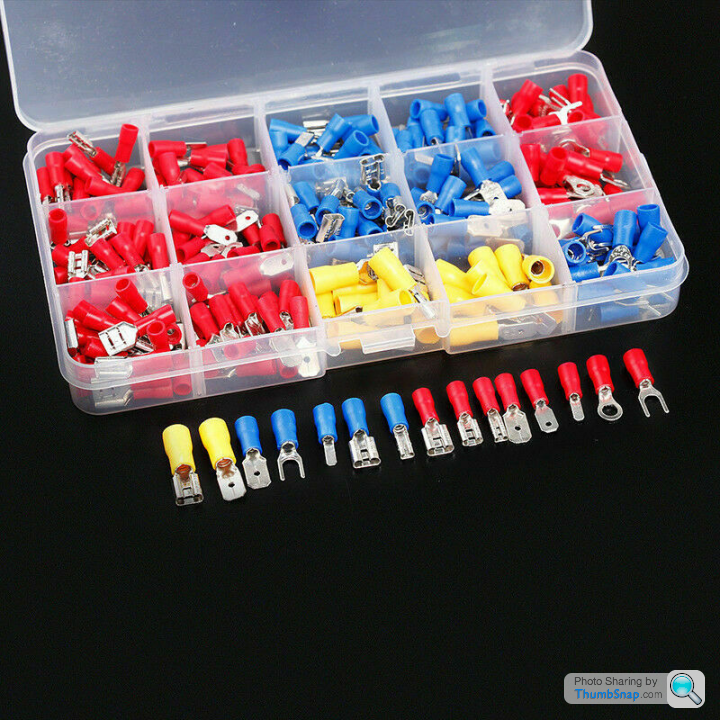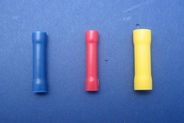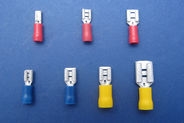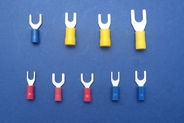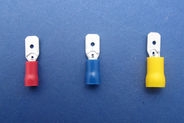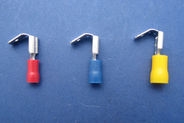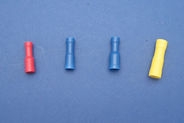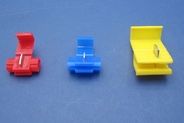Soldering Wire
Discussion
GreenV8S said:
I'm not saying it's impossible to create a good soldered joint, just pointing out the possible pitfalls. Crimping is almost universally recognised as superior to soldering when done right, and part of the reason for that is the potential for wiring damage due to solder wicking beyond the joint.
Universally?By who?
And any say I've ever seen or heard of wiring damage caused by soldering in my life other then people getting it too hot and melting insulation
227bhp said:
Penelope Stopit said:
What are they then? You can't get the plastic bit off (to use solder) easily, so whilst I agree they're carp, what are you supposed to do with them?Apart from put them in the bin

They don't crimp on they crush on
Penelope Stopit said:
227bhp said:
Penelope Stopit said:
What are they then? You can't get the plastic bit off (to use solder) easily, so whilst I agree they're carp, what are you supposed to do with them?Apart from put them in the bin

They don't crimp on they crush on
darreni said:
What are proper crimps? I've used the ones shown before, but have never been totally happy with them.
What I think of as 'proper' crimp terminals have two ears that are folded over and pressed into the conductor during the crimping procedure, and a further pair of ears that crimp over the insulation to provide strain relief. When you use this type and crimp them properly you end up with essentially a solid copper joint with no voids between the conductor and the terminal.The crush terminals develop a strong mechanical connection but in my experience also leave the conductor distorted and not filling the whole terminal.
Chris32345 said:
Universally?
By who?
In the case of wire to wire joints then NASA, Boeing, Airbus, every pro-motorsport team ever and realistically anyone in the fortunate position to be exposed to the "correct" way of doing things. By who?
Jointing of wires etc. is best done in this situation with something like a Duraseal adhesive lined shrink crimp:


It can be done with nothing more than a basic crimp tool and a hot air gun, is hermetically sealed, stronger than the wire was before it was jointed and has no vibration or strain relief issues like a solder joint. The former of which is the major issue with soldered wire to wire joints. The downside of a Duraseal is bulk, if minimising bulk is required then something like a TE PIDG (Pre-Insulated Diamond Grip) or Raychem Mini Seal is a good choice, although they are not adhesive lined they do both have sealing rings and provide a smaller CSA than a Duraseal - they do require a bit more of a proper crimp tool though as well as some post crimp assembly.
Realistically with modern wire and termination/connector technology solder is only suitable for PCBs and the odd ancient/weird mil-spec Amphenol connector.
Lets be honest though regardless of all this people will still insist solder is fine, they've used it for years without issue, all of the above is completely wrong and they'll carry on blobbing solder about the place, taping said joint up with 50p insulation tape and it'll probably work just long enough for it to not be their problem next time in a road car

poppopbangbang said:
In the case of wire to wire joints then NASA, Boeing, Airbus, every pro-motorsport team ever and realistically anyone in the fortunate position to be exposed to the "correct" way of doing things.
Jointing of wires etc. is best done in this situation with something like a Duraseal adhesive lined shrink crimp:


It can be done with nothing more than a basic crimp tool and a hot air gun, is hermetically sealed, stronger than the wire was before it was jointed and has no vibration or strain relief issues like a solder joint. The former of which is the major issue with soldered wire to wire joints. The downside of a Duraseal is bulk, if minimising bulk is required then something like a TE PIDG (Pre-Insulated Diamond Grip) or Raychem Mini Seal is a good choice, although they are not adhesive lined they do both have sealing rings and provide a smaller CSA than a Duraseal - they do require a bit more of a proper crimp tool though as well as some post crimp assembly.
Realistically with modern wire and termination/connector technology solder is only suitable for PCBs and the odd ancient/weird mil-spec Amphenol connector.
Lets be honest though regardless of all this people will still insist solder is fine, they've used it for years without issue, all of the above is completely wrong and they'll carry on blobbing solder about the place, taping said joint up with 50p insulation tape and it'll probably work just long enough for it to not be their problem next time in a road car
Yes I'm sure NASA uses these rather then just having one straight run of wires with no joint'sJointing of wires etc. is best done in this situation with something like a Duraseal adhesive lined shrink crimp:


It can be done with nothing more than a basic crimp tool and a hot air gun, is hermetically sealed, stronger than the wire was before it was jointed and has no vibration or strain relief issues like a solder joint. The former of which is the major issue with soldered wire to wire joints. The downside of a Duraseal is bulk, if minimising bulk is required then something like a TE PIDG (Pre-Insulated Diamond Grip) or Raychem Mini Seal is a good choice, although they are not adhesive lined they do both have sealing rings and provide a smaller CSA than a Duraseal - they do require a bit more of a proper crimp tool though as well as some post crimp assembly.
Realistically with modern wire and termination/connector technology solder is only suitable for PCBs and the odd ancient/weird mil-spec Amphenol connector.
Lets be honest though regardless of all this people will still insist solder is fine, they've used it for years without issue, all of the above is completely wrong and they'll carry on blobbing solder about the place, taping said joint up with 50p insulation tape and it'll probably work just long enough for it to not be their problem next time in a road car

poppopbangbang said:
In the case of wire to wire joints then NASA, Boeing, Airbus, every pro-motorsport team ever and realistically anyone in the fortunate position to be exposed to the "correct" way of doing things.
Jointing of wires etc. is best done in this situation with something like a Duraseal adhesive lined shrink crimp:
Realistically with modern wire and termination/connector technology solder is only suitable for PCBs and the odd ancient/weird mil-spec Amphenol connector.
Lets be honest though regardless of all this people will still insist solder is fine, they've used it for years without issue, all of the above is completely wrong and they'll carry on blobbing solder about the place, taping said joint up with 50p insulation tape and it'll probably work just long enough for it to not be their problem next time in a road car
tbh this is consistent with what I've heard too about quality crimps being preferred over solder due to potential failure.Jointing of wires etc. is best done in this situation with something like a Duraseal adhesive lined shrink crimp:
- pictures of fancy crimps*
Realistically with modern wire and termination/connector technology solder is only suitable for PCBs and the odd ancient/weird mil-spec Amphenol connector.
Lets be honest though regardless of all this people will still insist solder is fine, they've used it for years without issue, all of the above is completely wrong and they'll carry on blobbing solder about the place, taping said joint up with 50p insulation tape and it'll probably work just long enough for it to not be their problem next time in a road car

That said, I am s
 t at using the crimps neatly (probably a case of not having high quality crimp tool, high quality crimps, enough experience with doing them). for cars and bikes, I'll always solder purely because I'm better at it, and I'm a sad act so I enjoy it.
t at using the crimps neatly (probably a case of not having high quality crimp tool, high quality crimps, enough experience with doing them). for cars and bikes, I'll always solder purely because I'm better at it, and I'm a sad act so I enjoy it.Not sure I'd agree with the blobbing solder insulation tape situation though. Maybe some of the bodgers, but definitely not what I do.
Chris32345 said:
Yes I'm sure NASA uses these rather then just having one straight run of wires with no joint's
Tbh he's right about htem using crimps:https://nepp.nasa.gov/files/27631/NSTD87394A.pdf
Not that they don't solder too.
bluezedd said:
Tbh he's right about htem using crimps:
https://nepp.nasa.gov/files/27631/NSTD87394A.pdf
Not that they don't solder too.
Take a look at p55 13.3.1 . Makes interesting reading re the solder "wicking."https://nepp.nasa.gov/files/27631/NSTD87394A.pdf
Not that they don't solder too.
The proper aerospace crimps actually put so much pressure on the conductor wires they " weld " to the conductors ,to form an ohmic connection, at least that is what I was told.
Soldering is not " best practice " but as mentioned several times above ,works
OK for a reasonable length of time if done carefully ie joints physically supported and in none flexing areas of the harness .
Still doesn't make it right though !
Okay so the magical non crush connectors are crush connectors. After a classic PH thread diversion for no reason we are back to solder vs crush connectors again.
Crushing a crush connector properly 'does not equal' new clever type of connector.
Having built in heat shrink when you can simply apply heat shrink to any connection including solder 'does not equal' new clever type of connector.
As we were, please continue gentlemen.
Crushing a crush connector properly 'does not equal' new clever type of connector.
Having built in heat shrink when you can simply apply heat shrink to any connection including solder 'does not equal' new clever type of connector.
As we were, please continue gentlemen.
julian64 said:
Okay so the magical non crush connectors are crush connectors. After a classic PH thread diversion for no reason we are back to solder vs crush connectors again.
Crushing a crush connector properly 'does not equal' new clever type of connector.
Having built in heat shrink when you can simply apply heat shrink to any connection including solder 'does not equal' new clever type of connector.
As we were, please continue gentlemen.
Crimps fold around the conductors, crush-ons are too close to a cut for meCrushing a crush connector properly 'does not equal' new clever type of connector.
Having built in heat shrink when you can simply apply heat shrink to any connection including solder 'does not equal' new clever type of connector.
As we were, please continue gentlemen.
Auntieroll said:
The proper aerospace crimps actually put so much pressure on the conductor wires they " weld " to the conductors
With regards to the whole solder/crimp argument I am personally in the solder camp but appreciate that others are elsewhere & I don't have an issue with that, but that statement is complete b0ll0cks.I know you are saying it is what you were told & this is not a dig at you but if you were to cut away the connection the wire strands are still separate, so welding is not what is going on in there when they are crimped.
Gassing Station | Home Mechanics | Top of Page | What's New | My Stuff



